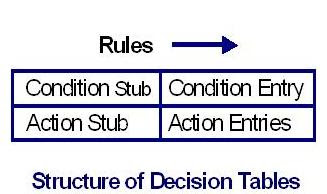What is Decision Table in Software Testing?
Boundary Value Analysis and Equivalence partitioning, both
are depend on specific situations or the inputs. Means if the situation is
definite then these techniques will work otherwise these will become very
complicated. Here we have two another specification – based techniques, i.e. decision
tables and state transition testing, these will more focused on business
logic or business rules.
A Decision Table technique also referred to ‘Cause
–Effort’ Technique. Decision Table is a good way to handle or manage the
testing where multiple type of input can be used.
Decision table is so much helpful and easy to use because it
has several options where user can use multiple values / inputs without any
confusion and can complete the required testing work properly.
- Decision tables provide an efficient mode of stating difficult industry rules, which is useful for testers as well as for developers.
- Decision tables can be used to explore the effects of combinations of different inputs and help the test engineers. These also used to test the design whether used in specifications or not.
- This table helps tester and developer to do their job better in efficient way.
Use of Decision Tables in Test Designing:
Simply manage the inputs in the table format is called the
decision table. Just pick out the suitable combination of inputs or events and
manage all these by the table. Please don’t take too many inputs so the
unmanageable situation can not be generated.
Definition: Decision tables are accurate and
compressed technique to copy problematical logic. They are perfect for telling
circumstances in which a number of arrangements of events are in use under
varying sets of circumstances.
Structure of decision table:
 |
| Structure of Decision Tables |
i.
Entry portion
ii.
Stub Portion
iii.
Action portion and
iv.
Condition portion
Advantages of Decision tables:
i.
Prevent the iterative work
ii.
Completeness property
iii.
Declarative property
Disadvantages of Decision Tables:
Ø
Scaling up is not well of decision
tables. We need to “factor” or divided the large tables into small ones to
remove the redundancy.
Decision Tables Applications:
i.
Important if-then-else condition
ii.
Reasonable associations among input values.
iii.
Computations involving splits of the
input values.
iv.
In between inputs and outputs cause – and
– effect relationships
v.
High cyclomatic difficulty.
Decision Table Technique to use: Techniques are the
guidelines for decision table based testing. Simply how one can use decision
table for testing.
|
|
|
|
|
|
|
|
|
|
|
|
|
|
||
|
|
|
|
|
|
|
|
|
|
|
|
|
|
|
|
|
|
|
|
|
|
|
|
|
|
||
|
|
|
|
|
|
structure and
definition of decision table, guidelines for decision table based testing, technique
of using decision table, applications of decision tables, advantage and
disadvantage of decision table.










No comments:
Post a Comment